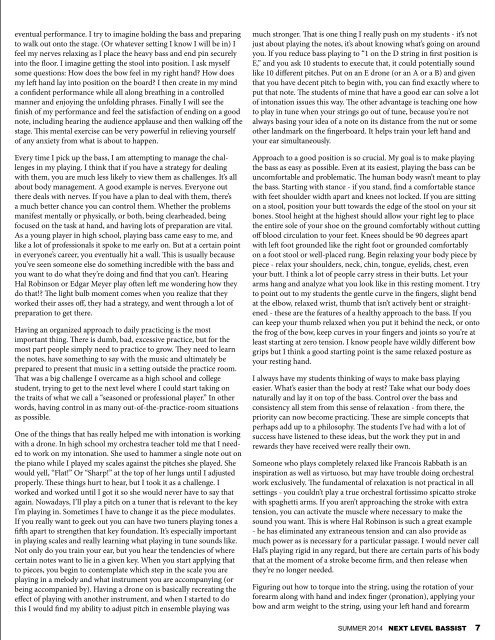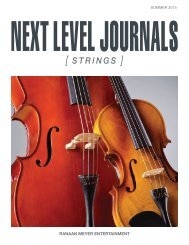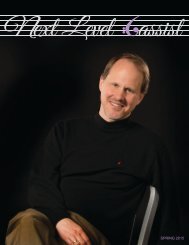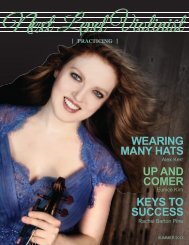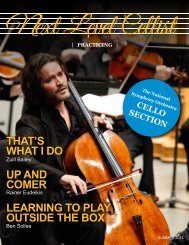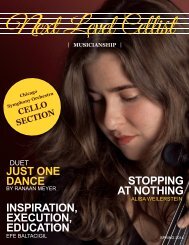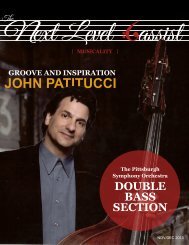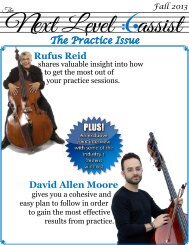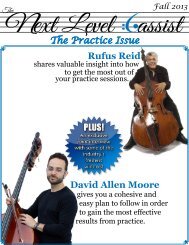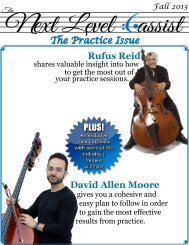Next Level Bassist Left Hand
Summer 2014 edition of Next Level Bassist. Left hand techniques and exercises by Nicholas Walker, Jordan Anderson, Paul Kowert. Section Spotlight on Cleveland Orchestra. Up and Comers Tim Dilenschneider and Jordan Morton
Summer 2014 edition of Next Level Bassist. Left hand techniques and exercises by Nicholas Walker, Jordan Anderson, Paul Kowert. Section Spotlight on Cleveland Orchestra. Up and Comers Tim Dilenschneider and Jordan Morton
You also want an ePaper? Increase the reach of your titles
YUMPU automatically turns print PDFs into web optimized ePapers that Google loves.
eventual performance. I try to imagine holding the bass and preparing<br />
to walk out onto the stage. (Or whatever setting I know I will be in) I<br />
feel my nerves relaxing as I place the heavy bass and end pin securely<br />
into the floor. I imagine getting the stool into position. I ask myself<br />
some questions: How does the bow feel in my right hand? How does<br />
my left hand lay into position on the board? I then create in my mind<br />
a confident performance while all along breathing in a controlled<br />
manner and enjoying the unfolding phrases. Finally I will see the<br />
finish of my performance and feel the satisfaction of ending on a good<br />
note, including hearing the audience applause and then walking off the<br />
stage. This mental exercise can be very powerful in relieving yourself<br />
of any anxiety from what is about to happen.<br />
Every time I pick up the bass, I am attempting to manage the challenges<br />
in my playing. I think that if you have a strategy for dealing<br />
with them, you are much less likely to view them as challenges. It’s all<br />
about body management. A good example is nerves. Everyone out<br />
there deals with nerves. If you have a plan to deal with them, there’s<br />
a much better chance you can control them. Whether the problems<br />
manifest mentally or physically, or both, being clearheaded, being<br />
focused on the task at hand, and having lots of preparation are vital.<br />
As a young player in high school, playing bass came easy to me, and<br />
like a lot of professionals it spoke to me early on. But at a certain point<br />
in everyone’s career, you eventually hit a wall. This is usually because<br />
you’ve seen someone else do something incredible with the bass and<br />
you want to do what they’re doing and find that you can’t. Hearing<br />
Hal Robinson or Edgar Meyer play often left me wondering how they<br />
do that!? The light bulb moment comes when you realize that they<br />
worked their asses off, they had a strategy, and went through a lot of<br />
preparation to get there.<br />
Having an organized approach to daily practicing is the most<br />
important thing. There is dumb, bad, excessive practice, but for the<br />
most part people simply need to practice to grow. They need to learn<br />
the notes, have something to say with the music and ultimately be<br />
prepared to present that music in a setting outside the practice room.<br />
That was a big challenge I overcame as a high school and college<br />
student, trying to get to the next level where I could start taking on<br />
the traits of what we call a “seasoned or professional player.” In other<br />
words, having control in as many out-of-the-practice-room situations<br />
as possible.<br />
One of the things that has really helped me with intonation is working<br />
with a drone. In high school my orchestra teacher told me that I needed<br />
to work on my intonation. She used to hammer a single note out on<br />
the piano while I played my scales against the pitches she played. She<br />
would yell, “Flat!” Or “Sharp!” at the top of her lungs until I adjusted<br />
properly. These things hurt to hear, but I took it as a challenge. I<br />
worked and worked until I got it so she would never have to say that<br />
again. Nowadays, I’ll play a pitch on a tuner that is relevant to the key<br />
I’m playing in. Sometimes I have to change it as the piece modulates.<br />
If you really want to geek out you can have two tuners playing tones a<br />
fifth apart to strengthen that key foundation. It’s especially important<br />
in playing scales and really learning what playing in tune sounds like.<br />
Not only do you train your ear, but you hear the tendencies of where<br />
certain notes want to lie in a given key. When you start applying that<br />
to pieces, you begin to contemplate which step in the scale you are<br />
playing in a melody and what instrument you are accompanying (or<br />
being accompanied by). Having a drone on is basically recreating the<br />
effect of playing with another instrument, and when I started to do<br />
this I would find my ability to adjust pitch in ensemble playing was<br />
much stronger. That is one thing I really push on my students - it’s not<br />
just about playing the notes, it’s about knowing what’s going on around<br />
you. If you reduce bass playing to “1 on the D string in first position is<br />
E,” and you ask 10 students to execute that, it could potentially sound<br />
like 10 different pitches. Put on an E drone (or an A or a B) and given<br />
that you have decent pitch to begin with, you can find exactly where to<br />
put that note. The students of mine that have a good ear can solve a lot<br />
of intonation issues this way. The other advantage is teaching one how<br />
to play in tune when your strings go out of tune, because you’re not<br />
always basing your idea of a note on its distance from the nut or some<br />
other landmark on the fingerboard. It helps train your left hand and<br />
your ear simultaneously.<br />
Approach to a good position is so crucial. My goal is to make playing<br />
the bass as easy as possible. Even at its easiest, playing the bass can be<br />
uncomfortable and problematic. The human body wasn’t meant to play<br />
the bass. Starting with stance - if you stand, find a comfortable stance<br />
with feet shoulder width apart and knees not locked. If you are sitting<br />
on a stool, position your butt towards the edge of the stool on your sit<br />
bones. Stool height at the highest should allow your right leg to place<br />
the entire sole of your shoe on the ground comfortably without cutting<br />
off blood circulation to your feet. Knees should be 90 degrees apart<br />
with left foot grounded like the right foot or grounded comfortably<br />
on a foot stool or well-placed rung. Begin relaxing your body piece by<br />
piece - relax your shoulders, neck, chin, tongue, eyelids, chest, even<br />
your butt. I think a lot of people carry stress in their butts. Let your<br />
arms hang and analyze what you look like in this resting moment. I try<br />
to point out to my students the gentle curve in the fingers, slight bend<br />
at the elbow, relaxed wrist, thumb that isn’t actively bent or straightened<br />
- these are the features of a healthy approach to the bass. If you<br />
can keep your thumb relaxed when you put it behind the neck, or onto<br />
the frog of the bow, keep curves in your fingers and joints so you’re at<br />
least starting at zero tension. I know people have wildly different bow<br />
grips but I think a good starting point is the same relaxed posture as<br />
your resting hand.<br />
I always have my students thinking of ways to make bass playing<br />
easier. What’s easier than the body at rest? Take what our body does<br />
naturally and lay it on top of the bass. Control over the bass and<br />
consistency all stem from this sense of relaxation - from there, the<br />
priority can now become practicing. These are simple concepts that<br />
perhaps add up to a philosophy. The students I’ve had with a lot of<br />
success have listened to these ideas, but the work they put in and<br />
rewards they have received were really their own.<br />
Someone who plays completely relaxed like Francois Rabbath is an<br />
inspiration as well as virtuoso, but may have trouble doing orchestral<br />
work exclusively. The fundamental of relaxation is not practical in all<br />
settings - you couldn’t play a true orchestral fortissimo spicatto stroke<br />
with spaghetti arms. If you aren’t approaching the stroke with extra<br />
tension, you can activate the muscle where necessary to make the<br />
sound you want. This is where Hal Robinson is such a great example<br />
- he has eliminated any extraneous tension and can also provide as<br />
much power as is necessary for a particular passage. I would never call<br />
Hal’s playing rigid in any regard, but there are certain parts of his body<br />
that at the moment of a stroke become firm, and then release when<br />
they’re no longer needed.<br />
Figuring out how to torque into the string, using the rotation of your<br />
forearm along with hand and index finger (pronation), applying your<br />
bow and arm weight to the string, using your left hand and forearm<br />
SUMMER 2014 NEXT LEVEL BASSIST<br />
7


